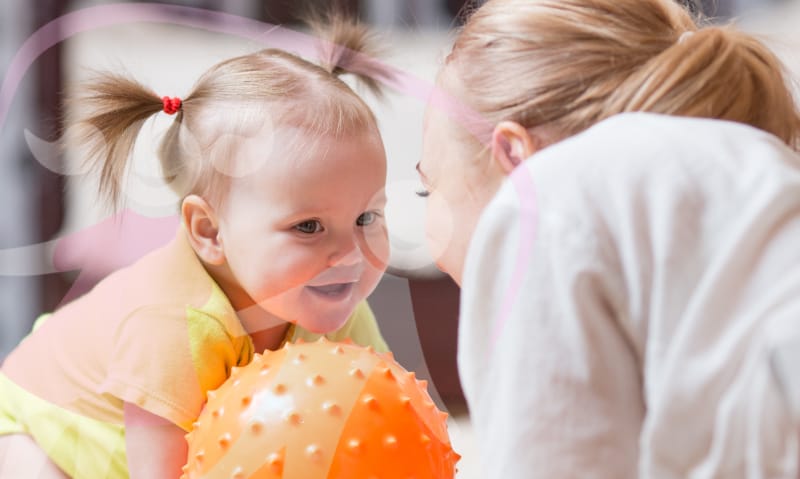A Parents’ Guide to Healthy Teeth for Babies and Toddlers

Healthy teeth From Infancy to Kindergarten
Infancy through toddlerhood is a really exciting time for parents! You’re watching your baby grow and hit important milestones, like saying their first words or taking their first step. The arrival of pearly white baby teeth is another big one, which often triggers parents to wonder about caring for their baby’s quickly developing smile and what are the best ways to help their child have healthy teeth.
What’s happening with your child’s smile from birth to five years?
Before diving into caring for your baby or toddler’s smile and helping them have healthy teeth, here are some important things you should know about general development.
Your baby’s first tooth will begin to come in around six to 10 months of age.
Somewhere between the age of six to 10 months, you should notice that your baby’s primary teeth are starting to come in. The first teeth to come in are the central incisors, or the very front teeth on the top and bottom. Most kids will gain each new tooth, starting from the front to the back, beginning with their incisors and ending with the molars.
By age three, your toddler will have all of their primary teeth and a full smile.
Around two-and-a-half to three years of age, your toddler should have a full smile with all of their primary teeth in place. Keep in mind that many eruption charts, like this one from the ADA, have a pretty broad range of time for when a tooth may arrive. As long as your child is developing normally and under the supervision of a dentist, there’s nothing to worry about if a rear molar is taking a little longer to erupt.
Natural loss of baby teeth can sometimes begin as early as four years of age.
If your child’s baby teeth arrived on an earlier schedule than average, they may also experience earlier shedding or loss of their baby teeth. Most kids will be between the ages of six or seven when they lose their first tooth, but this can also happen as young as four or five. Again, as long as your child’s progress is being monitored by a pediatric dentist, there often isn’t any reason for worry.
Your Baby’s First Experiences With Their New Dentist
Your baby’s first dentist is going to be their best friend when it comes to protecting their oral health and helping your child have healthy teeth.
Your baby’s first visit to the dentist should take place by their first birthday.
General guidelines for a baby’s first dental appointment are to book a visit within six months of their first tooth erupting or no later than their first birthday. This may seem very early, but it’s for good reason. The sooner your baby begins to get used to visiting their dentist, the sooner they’ll begin to develop a trusting, confident relationship with the dental care team.
When choosing a dental home, pick one with a board-certified pediatric dentist.
Your general or family dentist may allow kids as patients, but consider choosing a board-certified pediatric dentist instead. A dedicated pediatric dental practice has extensive additional training in kids’ dental care, including diagnosis, treatment, and handling. A friendly, welcoming pediatric dental care team will provide the comfort and skills to make your baby or toddler feel calm and relaxed.
Your baby’s pediatric dentist can also perform a lip and tongue tie evaluation.
Lip and tongue ties are fairly common issues parents may face with their young children. The good news is many board-certified pediatric dentists can also diagnose and treat lip and tongue ties. Modern dental practices even offer soft-tissue laser dentistry for treatment, resulting in greater comfort, minimal need for anesthesia, and a faster healing time afterward.
Creating an Effective At-Home Early Dental Care Routine
At-home dental care ensures your baby or toddler’s smile is cavity-free, which is key to having healthy teeth.
It’s never too early to start caring for your baby’s smile.
Early dental care usually begins when you notice your baby’s first tooth beginning to erupt. Even though your child’s smile is pretty gummy at this time, you can still keep their gums and emerging teeth clean with a damp washcloth. Once more teeth erupt, you can switch to a toothbrush or finger brush designed for infants and toddlers.
The sooner your baby gets used to having their mouth cleaned on a twice-daily basis, the easier of a time they’ll have transitioning to brushing and flossing.
Use oral care products that are age-appropriate and dentist-approved.
It’s important to use only ADA-recommended oral care products that are designed for kids. Your child’s pediatric dentist will inform you of when to begin using fluoride toothpaste and demonstrate the very small amount that should be used. As your toddler grows older, their dentist will guide you through any changes you should make to their daily dental care routine.
Be aware of fluoride in kids’ oral care products until they learn to spit.
Fluoride is a wonderful naturally occurring mineral that is added to many oral care products. However, it shouldn’t be ingested in large quantities. When choosing oral care products for your child, be careful that you aren’t using more than advised. Toddlers can struggle with spitting out toothpaste or mouthwash at first, reflexively swallowing it instead. Until your child is able to spit easily every time, wait on adding fluoride mouthwashes to their routine.
Your child’s dentist will also be able to safely apply fluoride varnish and dental sealants to aid in cavity prevention.
Begin your child’s journey to a healthy smile and teeth by scheduling a dental checkup.
Are you looking for a pediatric dentist in Omaha? Dr. Reimer always welcomes new patients and their families.
You can book your child’s dental appointment or evaluation today by calling our office or filling out this online form.